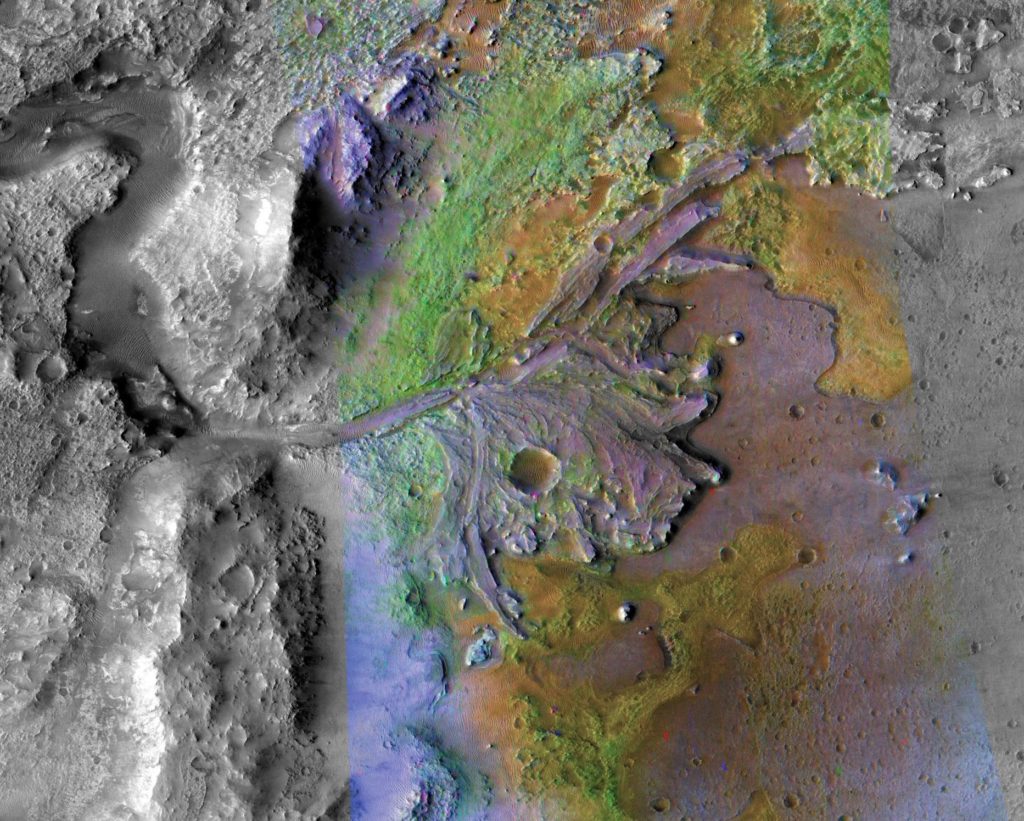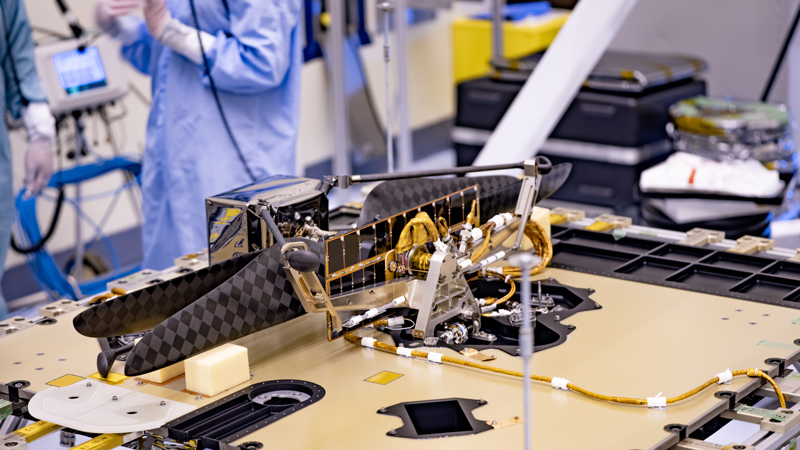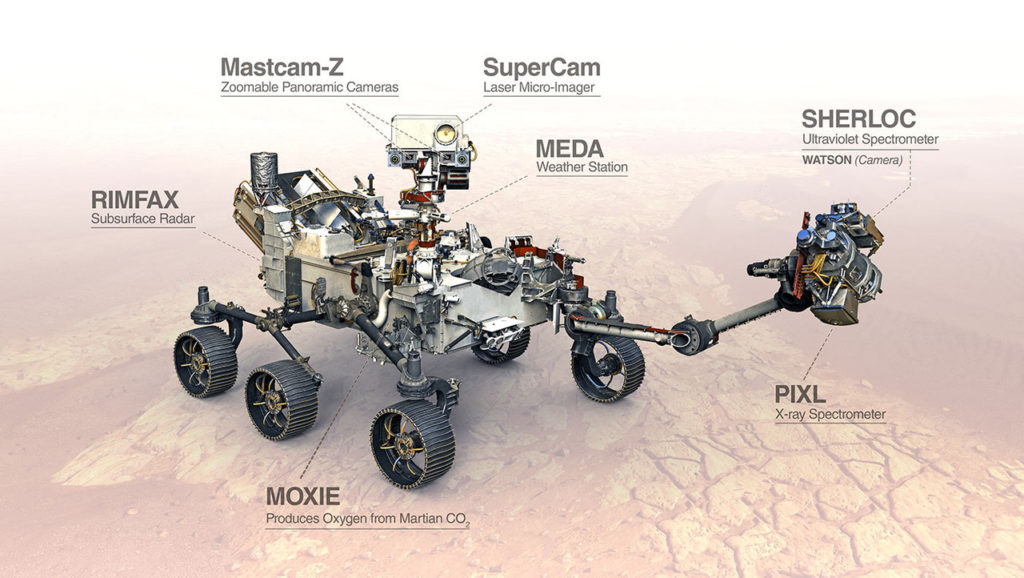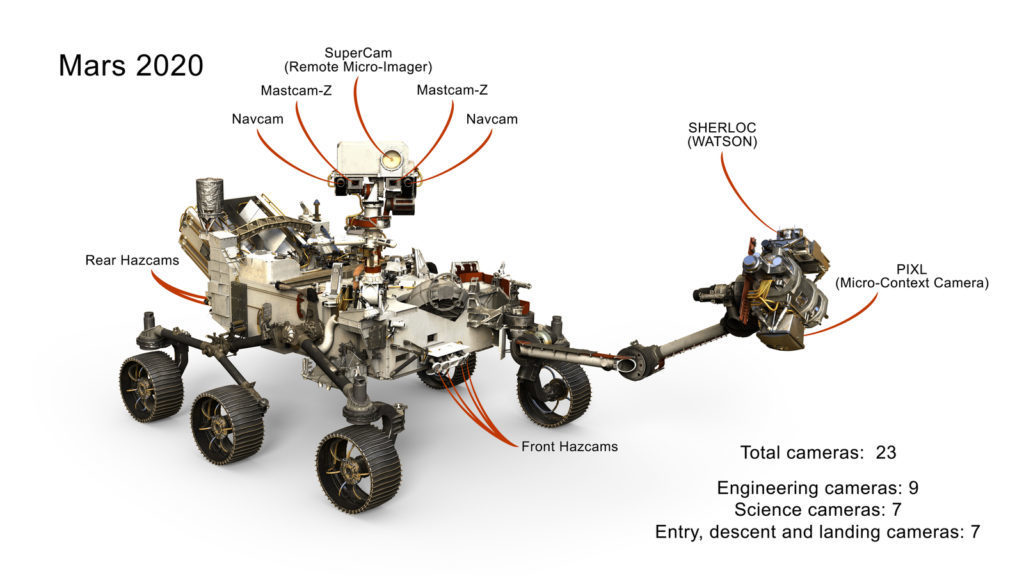In 2021 NASA’s new Mars 2020 Perseverance Rover will land on the Red Planet.
As it looks mostly like the previous rovers sent to Mars, so how is Perseverance so different? Well it is a totally new rover with new and exciting capabilities and innovations not seen on other the rovers before.
Other Mars rovers
To compare the science and the landing technique used let’s look at some of the previous rovers that landed on Mars.
Pathfinder launched in 1996, that was sent to Mars to test the feasibility of low-cost landings on and exploration of the Martian surface.
It landed using an airbag system allowing the craft to bounce to a landing on the planet. The successful mission ended in September 1997.
In 2004 the twin Mars Rovers Spirit and Opportunity landed on Mars by also by using air bags. Spirit performed until communication was lost in 2010. And due to a planetary dust storm, Opportunity stopped communicating in 2018.
Because of dust covering the solar panels, Opportunity was never able to recharge its batteries so NASA, in 2019, officially declared Opportunity dead after 14 years of operation.
NASA’s next rover, Curiosity landed on Mars in 2012. Curiosity was twice as long and 5 times heavier than Spirit and Opportunity so it couldn’t land with airbags like they did.
Instead, NASA developed a landing system consisting of a parachute, descent vehicle, and an approach called a skycrane maneuver for lowering the rover on a tether to the surface during the final seconds before landing.
Curiosity looked at the role water played on Mars and continues to explore the planet’s past habitability.
Perseverance Rover mission overview
NASA’s Perseverance mission is not different from any of those other rover mission however, Each of the past rovers landing sites offered different opportunities for exploration, with experiments to consider the possibility of past microbial life, examine Martian soil, rocks, and ground level atmosphere looking for signs of previous life. They were essentially doing robotic field geology.
The new Perseverance Rover will continue this science but will also concentrate on science that will help pave the way for human life on Mars someday.
The Perseverance rover helps prepare for future human exploration of Mars by testing a technology for extracting oxygen from the Martian atmosphere, which is 96 percent carbon dioxide.
This new technology helps mission planners test ways of using Mars natural resources to support human explorers and improve designs for life support, transportation, and other important systems for living and working on Mars.
The Mars 2020 Perseverance Rover uses the same landing technique developed for Curiosity. Perseverance Rover however adds some amazing improvements with new entry, descent and landing technologies, such as Terrain Relative Navigation (TRN).
Terrain Relative Navigation allows the rover to detect and to avoid hazardous terrain by diverting around obstacles during its descent through the Martian atmosphere.
Previous rovers simply landed and for the most part hoped that the landing would be uneventful. Also, brand new on the Mars Perseverance Rover is a system called Range Trigger. Previous rovers landed but were not necessarily as close to the exact landing spot as desired. The rover would then have to be driven to the desired exploration spot and that could take days or more.
Range Trigger tells the parachute when to open so that Perseverance can land closer to the exact desired landing spot in the landing area, shaving off as much as a year from the rover’s final arrival at its prime work site.
This time, in addition to a full color camera, a microphone has been added which allows engineers to better analyze entry, descent, and landing.
Jezero Crater

NASA’s new Perseverance Rover lands at Jezero Crater. Jezero Crater formed billions of years ago and water filled it to form a deep lake about the same size as Lake Tahoe.
Jezero Crater formed when a large object collided with Mars, excavating rocks from deep in the Martian crust, exposing them in the rim.
These rocks would have been hot shortly after the impact and may have hosted hot springs.
Deposits from these springs would be another target in our search for possible ancient life on Mars.
Although the rovers can analyze Martian samples while on Mars, there are some things that scientists cannot do with a robot on Mars.
This is another exciting addition to Perseverance Rover, something that has never been done before. A sample collection and caching system has been added to the rover’s capabilities.
Perseverance will collect at least 20 pencil-sized cores, drilled from Martian rocks, seal them in tubes, and store them.
NASA is confident that later missions will be able to retrieve those samples and return them to Earth for analysis.
One possibility is that a small rover can retrieve the cached samples and a rocket can propel them into Mars orbit. They would then be transferred to an orbiter that could return the samples to Earth.
Helicopter on Perseverance Rover
One of the coolest pieces of equipment carried on the Perseverance rover is the Mars Helicopter. The laws of physics say that it is nearly impossible to fly a heavier than air vehicle on Mars with its thin atmosphere.
Engineers however, going on the theory that if a helicopter is light enough and the blades spin fast enough, it should fly.

The helicopter is a small autonomous rotor-craft. It weighs in at just under 4 pounds. Its fuselage is about the size of a softball, and its twin, counter-rotating blades will bite into the thin Martian atmosphere at almost 3,000 rpm about 10 times the rate of a helicopter here on Earth.
The helicopter also contains built-in capabilities needed for operation on Mars, including solar cells to charge its lithium-ion batteries, and a heating mechanism to keep it warm through the cold Martian nights.
It will get to Mars attached to the belly pan of the Perseverance Rover. Once the helicopter is on the planet’s surface, a suitable location will be found to deploy the helicopter down from the vehicle and place it onto the ground.
The rover is then driven away from the helicopter to a safe distance from which it will relay commands.
After its batteries are charged, controllers on Earth will command the Mars Helicopter to take its first autonomous flight into history.
Since Earth will be several light minutes away, there is no way to joystick the helicopter from Earth so it will receive commands from the rover and then fly the mission on its own.
It will engage in a 30-day flight test including up to five flights of incrementally farther flight distances. On its first flight, the mars copter will make a short vertical climb to 10 feet where it will hover for about 30 seconds.
The Mars helicopter is considered a high-risk, high-reward project. If it does not work, the Mars 2020 mission won’t be affected.
But if it does work, helicopters may have a real future as low-flying scouts and aerial vehicles to access locations not reachable by ground travel.

Science Instruments
Although NASA has tried unsuccessfully before to send microphones to Mars, Perseverance will carry microphones on both its landing package and its SuperCam instrument.
The Super Cam mic will enable scientists to hear the sounds of Mars and the landing microphone allows engineers to analyze entry, descent, and landing and capture sounds of the rover at work.
Similar to REMS on Curiosity, MEDA is a set of sensors that will provide measurements of temperature, wind speed, direction, pressure, and relative humidity, as well as dust size and shape.
Information collected by MEDA will help design shelters for astronauts living on Mars.
Another new instrument called RIMFAX is a ground penetrating radar operated from ground level that will provide centimeter-scale resolution of the geologic structure of the subsurface.
This is the first time that Ground Penetrating Radar is used on the surface of Mars. Previous GPR observations have been conducted from orbiters.
Another brand-new instrument called MOXIE is totally different than any other instrument on past Rovers.
It is aimed directly at preparing for humans living on Mars. Scientists are hoping to demonstrate that we can change CO2 into oxygen.
MOXIE’s goal is to demonstrate that it can also make oxygen to fuel rockets so that future Mars explorers can return home to Earth.
Currently, a rocket capable of launching a crew and its equipment into orbit from Mars would need to be propelled by about 7 metric tons of methane and 27 metric tons of oxygen.
Getting all that oxygen to Mars for the return trip would require many launches from Earth just to get it there.
Since Mars atmosphere is primarily CO2 it is hoped that MOXIE could produce the required oxygen for the return trip, eliminating the need to transport oxygen from Earth.
Perseverance Rover cameras

The Mars Perseverance rover has 23 cameras, some new and some enhanced versions of the ones that are on Curiosity.
2 MASTCAM-Z CAMERAS will determine mineralogy of the Martian surface and assist with rover operations.
PIXL will provide capabilities that permit more detailed detection and analysis of chemical elements than ever before.
SHERLOC(Scanning Habitable Environments with Raman & Luminescence for Organics & Chemicals) will be able to determine whether organics that the lander detects are native to Mars or whether those organics came from a meteorite that bombarded Mars.
SHERLOC is also critical for NASA’s study of space suits that will be worn by astronauts on Mars.
NASA is sending a piece of an astronaut’s helmet and four kinds of spacesuit fabric aboard Perseverance.
This is the first time that spacesuit material has been sent to Mars and it will provide valuable information for protection of astronauts visiting Mars.
WATSON is one of the tools on the ARM or TURRET at the end of the robotic arm. It can take pictures of other arm-mounted instruments at work.
For example, it can be pointed at the oxygen-making experiment MOXIE to help monitor how much dust accumulates around the inlet that lets in Martian air for the extraction of oxygen.
SuperCam is the next generation of the ChemCam instrument now operating on Curiosity. It is mounted on the rover’s mast or head.
It can identify which elements in the Martian dust may be harmful to humans. Like ChemCam, SuperCam will shoot a laser at rocks from about 20 feet away to vaporize some of the rock and analyze the vapor.
SuperCam uses a more powerful green laser to determine if there are minerals that formed in the presence of liquid water.
The new microphone mounted on SuperCam will allow scientists to listen as the laser hits a target. The popping sound it makes changes depending on the rock’s material properties.
CachCam is also a brand-new camera that looks down at the top of the samples collected and cached. It takes pictures of sampled materials and the sample tubes as they are being prepared for sealing and caching.
This keeps a record of the entire process for each sample collected so that in the future when the means for returning these samples to Earth is developed, there will be a complete record of their being obtained and sealed.
Up look cameras can see the parachute’s inflation and see the descent stage in operation as it lowers the rover from the sky crane A Descent-stage camera views the rover from above and a down look camera views the ground.
2 NAVCAM CAMERAS are mounted high on the rover’s mast. These help engineers drive the rover around Mars.
Mounted at the front and rear of the rover’s body, pointing down toward the ground, are 2 front and 2 rear HAZCAMS which guide the rover and help steer around hazards while driving across the Martian surface.
The enhanced engineering cameras all share the same camera body, but use different lenses selected for each camera’s specific task. They will help in positioning the tools on the robotic arm.They are located at various places on the rover.
As astronauts travel through the solar system, they will need to communicate quickly with other spacecraft and with Earth. And, in emergencies, even hold video conferences.
NASA, looking ahead to human travel to Mars, and it is updating its Deep Space Network and is developing a communication system to operate at higher radio frequencies and at optical frequencies using laser communication systems.
A new internet system is being developed that will give each planet its own domain name, for example: www.alphabase.mars.
The new system will even compensate for the great time delay in communicating between bodies in space, including the distance between Mars and Earth, which is 29 minutes one way when Mars is closest to the Earth.
As humans push further into the exploration of our solar system and beyond, eventually we will take the next step beyond unmanned probes and take the first human step onto Mars.
Although humans have been exploring the science of the Red Planet for some time, learning about its geology, chemistry, past life and its mysteries.
We are now ready to start planning on how humans will take that first step onto another planet in our solar system.
Mars 2020 Perseverance Rover not only continues unmanned science exploration but now examines for the first time how humans themselves will land on, live on, and explore the Red Planet.
We will learn how to provide power for the explorers. We will learn how to provide breathable oxygen and generate fuel for a return trip back to Earth. We will learn how to provide food and drinking water allowing humans to stay on the surface.
The Perseverance Rover will give us the information we need to allow that first human step on Mars.
Launch Time
After a series of delays, Mars 2020 Perseverance Rover is now targeted to launch no earlier than July 30.
Date: 30 July
Place: Cape Canaveral Air Force Station, Florida
Additional Resources:
